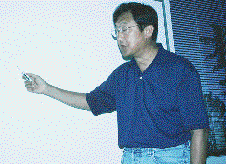|
GOLDSEA |
ASIAN AMERICAN RAGS-TO-RICHES SAGAS
MIDAS OF MEMORY
PAGE 5 OF 6
In Los Angeles Tu met David Sun through a mutual friend named Phillip Wang. Wang was the fifth Beatle--never talked about, never publicized, but there from day one. In the end he was quietly bought out, by Tu and Sun. They even payed him a second, larger sum when the money started flowing.
Sun was an engineer working for a company that made add-on products for Digital (DEC) minicomputers. He showed Tu a magazine and explained the future to him.
"He said, 'I know how much the materials cost. Look at the list price. Subtract the cost. That's our profit,'" says Tu. "We were so simple-minded."
In two weeks Sun designed a one-megabyte DEC-compatible memory board packed with 64k chips that could fetch $2,000. Tu took out a magazine ad and waited by the phone.
Still flush from his Scottsdale real estate deals, Tu could afford to manage the business while Sun kept his job as chief engineer at Alpha Micro Systems. The business consisted of 4 or 5 prototypes, one magazine ad, a phone, an old typewriter, Tu's two-finger typing skills and a name--Camintonn.
Mornings Tu manned the phones, fielding inquiries and transferring calls to departments that didn't exist. In the afternoon he took the phone off the hook, ran to the post office and mailed the three-line replies that had taken hours to type.
"I knew nothing about computers, nothing about memory," says Tu. "So I picked up the phone, pretending. David taught me some buzzwords, so I just started throwing out these words without knowing what I was saying."
For nearly a year, Tu was Camintonn. The phones rang, the interest was there, but nine months into it, not one board had been sold.
Then Digital called.
The minicomputer giant wanted to see specs. The pessimist, Tu told Sun DEC would probably sue for patent infringement. It was time to close shop. Two weeks later, DEC asked Tu to fly to Boston to make a presentation.
"I couldn't believe it," says Tu. "I said, 'You are DEC, we are copying you and you say our product is better than yours? I don't understand. If you want to sue me, please tell me now." The man on the other end laughed but couldn't divulge the reason for DEC's interest. Two weeks later DEC called again. They wanted to come out to California.
"I cannot see you right now," Tu stalled, fearing their cover was about to be blown. "How about April?" It was February.
Luckily, DEC was patient enough for Tu and Sun to rig up a tiny office and fill for the occasion with friends and family. The morning DEC arrived, Tu found himself in another jam. DEC was sending nine people. Tu had only four chairs.
[CONTINUED BELOW]
A friendly deli next door could spare a few chairs and three days of talks went smoothly. Not until the last day did Tu and Sun finally learn that DEC wanted to buy their design.
"Actually, they knew all along what game we were playing," says Tu. "I thought I was doing a good job, but all they cared about was that we had a good design."
That day Tu learned just how inflexible and bureaucratic big companies are. DEC needed a one-meg memory board for a new system that was ready to ship. But it would have cost DEC 10 months and $1 million to design its own board. DEC offered $250,000. Tu signed immediately.
"A lot of people later said that I jumped too fast," says Tu. "You should have held out for $2 million. But this is what I always say to people: Never be greedy. Chances are there's some competitor that will [step in].
"It was our turning point. If we hadn't cut that deal, today we probably wouldn't be in business."
Suddenly, Camintonn had a real office and $250,000 working capital. Life was good. By the end of '84 the company was selling $800,000 worth of memory a month to DEC customers. The beauty of it was, as with Kingston, Camintonn didn't have to create the demand. DEC generated the customers. And as technology progressed, those customers needed to upgrade. Their choice was to pay DEC their high prices or get a bargain from customer-friendly Cammintonn.
In 1986, Tu and Sun sold Camintonn to AST for $4 million cash and $2 million in AST stock. AST was looking to diversify. The company did its research, and the reputation Tu and Sun built preceded them. They stayed with AST for another year, until the birth of Kingston.
PAGE 6
PAGE 1 |
2 |
3 |
4 |
5 |
6 |
|
|
|
|


Tu explains why Kingston isn't so much in the technology business as in the service business.
|
<
|
"If you want to sue me, please tell me now."
|
CONTACT US
|
ADVERTISING INFO
© 1996-2013 Asian Media Group Inc
No part of the contents of this site may be reproduced without prior written permission.
|







